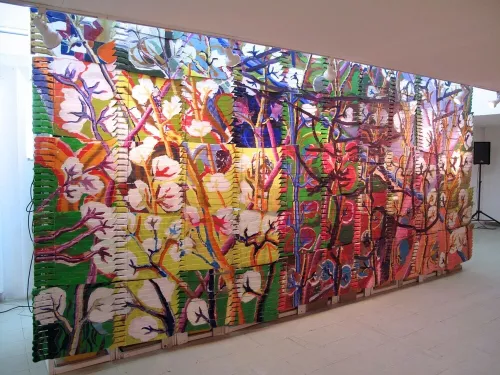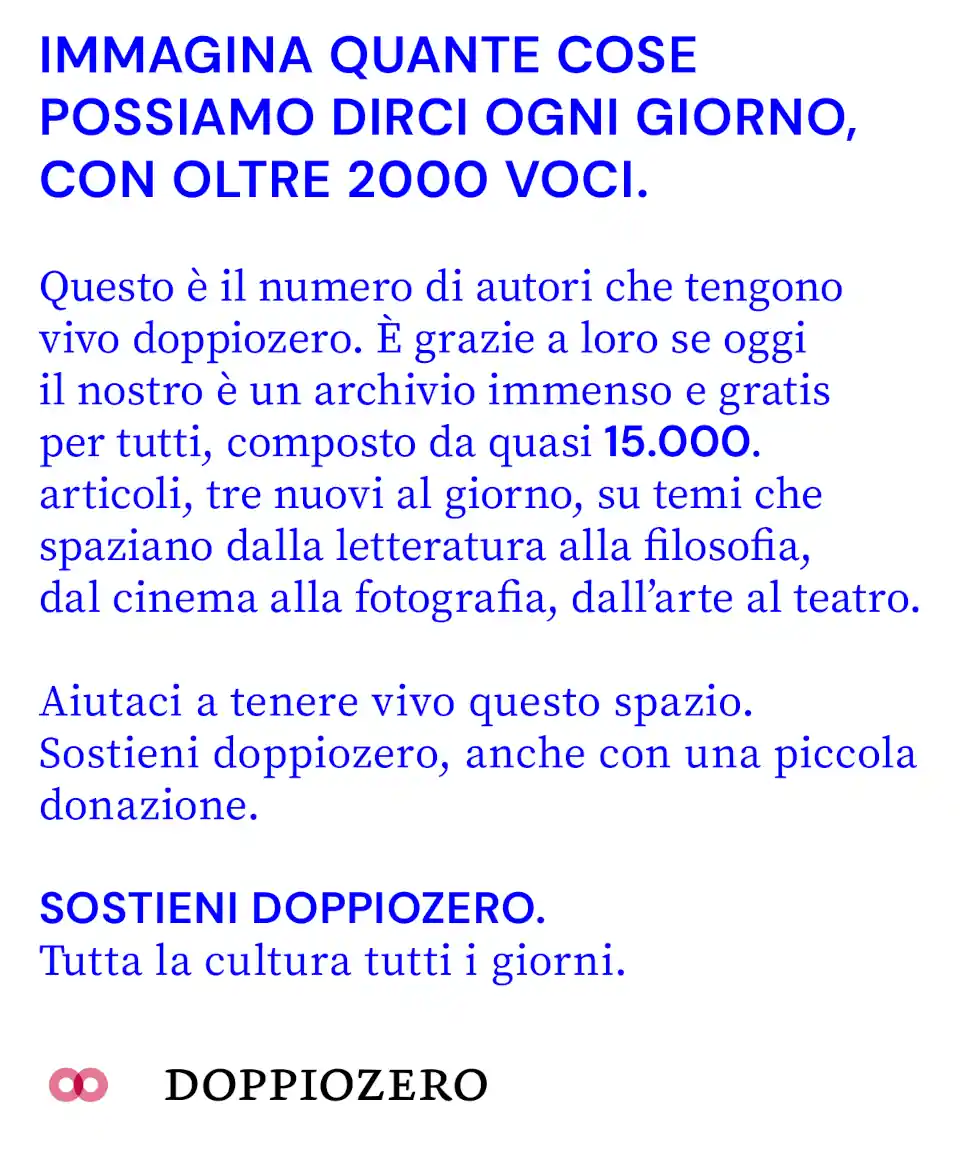Speciale
Tracing Emerging Contemporary Art Practice in Angola
We are happy to announce a new collaboration with online platform Another Africa. We share a common vision and passion to present a contemporary point of view on the continent and the Diaspora in all its complexity and variety of expression. This month we feature the first article from their "Tracing emerging contemporary artistic practice" series. It looks at the contemporary art scene of a country, in an effort to begin to understand current conditions and to highlight the work being done by emerging artists. Developed by Houghton Kinsman and Missla Libsekal, Another Africa founder, they have generously partnered with us to re-publish the series. The first focus is on Angola, one of the most artistically vibrant and stimulating art scenes on the continent. Enjoy
lettera27
Angola’s critically acclaimed presentation at the Venice Biennale in 2013 has become yet another significant stimulus in the country’s emergence as an exciting, developing arts destination in southern Africa.
With more than a decade passing since the end of 27 year civil, Luanda-based curator Suzana Sousa tells us in our interview that the, “international attention on the work of young artists has shaken the construction of artistic discourses,” in post-conflict Angola. Keenly aware of what these shifts could mean for Angola’s artistic eco-system at large, Sousa believes that it is exciting to see, “the balance, still in the making, between a global artistic language and reflections on local histories and aesthetic elements.”

Kiluanji Kia Henda. As God Wants and the Devil Likes It (O.R.G.A.S.M Congress) 2011-2013. Courtesy of the artist and Brundyn+
At the heart of these shifts in discourse has been the emergence and development of critical young artists like Paulo Kussy, Yonamine and Rita GT, alongside more established names like Nástio Mosquito, who recently won the Future Generation Art Prize 2014, and Edson Chagas, the artist behind Angola’s Venice pavilion winning exhibition, Luanda: Encyclopedic City.
The recent success of Chagas and Mosquito, has in turn highlighted the fact that there is a wave of growing interest in the local art scene. This sentiment is reinforced by news of Luanda-based business magnate and art collector Sindika Dokolo’s hopes of rallying the business and national energy sector- in an effort to return lost patrimony- to finance the buying back of ‘African’ artworks held privately and by museums in the West. It is also touted that, as the Foundation Sindika Dokolo collection continues to grow, Dokolo has plans to address some of the country’s infrastructural shortcomings by building a museum in Luanda.


Francisco Vidal. Post-it series, 2010. Courtesy of the artist
Despite the infancy of these projects, events like these do serve to reinforce, as RitaGT alludes to in our interview, that the general sentiment is that in Angola, “potential is not lacking.” And, as the architects of emerging discourse, it is hoped that the success of these critical young artists-locally and further abroad-will translate into tangible local initiatives that lead to vitality, increased cultural awareness, and potentially, local institutional support for the arts.
Therefore, playing our part, we highlight three up-and-coming artists whose practice reflects the dynamism that Sousa and RitaGT describe. As a result of their critical practices and thought-provoking work, Francisco Vidal, Kiljuani Kia Henda and Binelde Hyrcan are relevant examples of emerging artists who add impetus to Angola’s burgeoning artistic environment.
Contributions to an ever-developing discourse:
Emphasising the role of young artists in emerging Angolan practice
Considering that Henda, Vidal and Hyrcan were born after 1975, what makes them so engaging is that both their lives and respective practices remain connected in one way or another to both the historic intersection of independence and the start of civil war, and recent political, economic and social transitions in 21st century Angola. As a result, whether operating locally in Angola or further abroad in the diaspora, they each explore issues informed by these past-present connections. For Henda, Angola is the epicenter of an investigative practice that critiques the representation of Africa and explores the reality of Angolan history, Hyrcan expounds upon the notions of power/vanity and Vidal explores his embodiment of a transcultural creolisation brought about by colonialism.
In addition to the criticality of their respective practices, it is their participation in exhibitions abroad, that has helped draw international awareness to emerging Angolan practice, and is helping foster this balance between a global artistic language and reflections on local histories. By exploring their respective practices, one can begin to understand the importance of their role in creating new directions for Angolan artistic discourse.
Kiljuani Kia Henda | Angola as Epicenter

View of the exhibition (2014) KILUANJI KIA HENDA As god wants and the devil likes it Courtesy of Brundyn+, Cape Town
Utilising a predominantly lens-based practice, Henda’s works speak to conceptions of Africa, its history and its future. His exhibition last September at Brundyn + in Cape Town, titled as god wants and the devil likes it, contemplated, “the aftermath of colonialism and its mark on the current Angolan physical, social and political landscape.” It is exactly this method of investigation that examines the way socio-political histories shape both the present and the future, that has earned him many plaudits.


Kiluanji Kia Henda. Balumuka (Ambush), 2010. Courtesy of the artist and Brundyn+, Cape Town
South Africa’s Arththrob publication editor Matthew Blackman has described Henda’s project Icarus 13, in which he fictionally documented an attempt by the Angolan government to send four astronauts to the Sun as, “one of the most profound and inventive projects of the last decade.”
But, perhaps his biggest accolade came in 2012, when he was awarded the National Prize for Culture from the Angolan Ministry of Culture for his contribution towards the internationalisation of Angolan art. This award came as a result of –amongst other things- his participation in the biennales at Venice, Sao Paulo, Lumbumbashi, Venice, and Guangzhou.
Furthermore, his work also has appeared in exhibitions at Galleria Fonti, Naples; Goethe-Institue, Narobi; Studio Museum, Harlem and Berardo Museum of Modern and Contemporary Art, Lisbon. Henda continues to live and work in Luanda and Lisbon.
Binelde Hyrcan | Ironic reflections on power
Based between Luanda and France, Binelde Hyrcan has become well known for his affinity for using full size sculptural fowl accoutered in royal garb, to ridicule notions of power and vanity.Working fluidly across the mediums of painting, sculpture, video, installation and performance, Hyrcan often employs irony and sarcasm as means to reflect upon what he describes as the, “power absurdity of people.”
Considering that he grew up in Angola during the civil war, before moving to France, it only seems natural that his practice would take its departure point from the power struggles that have plagued Angolan history. As a result his work speaks in part, to the inexorable consequences of unrelenting and egotistical conflict.
As for his penchant for working with distinctive garbs, one need only look as far as his appreciation for his mother’s sewing work as a child. (He speaks fondly of his fascination for how her Singer sewing machine worked and would not rest until he knew how to use it.)


View of the exhibition «No Fly Zone» at Museu Coleção Berardo artworks by Binelde Hyrcan, Thirteen Hours, 2011. Photograph: David Rato, 2013
Hyrcan has already participated in exhibitions in Milan at both the Palazzo Moriggia and Palazon Morando; in Lisbon at the Berardo Museum of Modern and Contemporary Art and in Sao Paulo at the Instituto de Cultura Contemporânea-alongside esteemed artists such as William Kentridge, Yinka Shonibare and the late Seydou Keïta.
Along with Henda, Hyrcan was also included in, «No Fly Zone» at Museu Coleção Berardo curated by Simon Njami, Suzana Sousa and Fernando Alvim.
Francisco Vidal | Embodying the trans-cultural notion of creolisation

Francisco Vidal. Installation view. Courtesy of the artist
Vidal operates a multi-disciplinary practice that includes drawing, sculpture and installation as a means to reflect upon the reality in which he lives. He has a vested interest in exploring notions of race, difference, negritude and the African Diaspora.

Francisco Vidal. Hindyra Mateta, Luanda, 2013. Courtesy of the artist.
He is recognised for his involvement with e.studio, a collective that he initiated along with artist Rita GT. Their objective has been to create art based on and influenced by Luanda, in order to help develop an international Angolan art movement. Consequently, e.studio has brought about a sense of structure and continuation to local art infrastructure, that has helped address two issues that Sousa believes demonstrates the, “fraught balance between public programs and private initiatives,” in Angola. e.studio has subsequently held exhibitions at the Luanda Triennal and Sala do Veado, Lisbon and was recently highlighted by Contemporary And.
Outside of e.studio, Vidal’s exhibitions include Exposição de Instalações de Jovens Artistas Angolanos (JAANGO), 2ª Edição at SIEXPO (Salão Internacional de Exposições de Arte) do Museu Nacional de História Natural, Luanda; Agora, a Seguir e Como at Museu de Arte, Viana deo Castelo; Piratería y Estudios sobre el Caballero de Calatrava at Museu Internacional do Chile, Chile and Golden Refugees at Estação de Metro -Baixa Chiado, Lisbon.
Furthermore, both Francisco Vidal and Binelde Hyrcan were selected, alongside Nelo Teixeira, Délio Jasse and Antonio Ole as Angola’s 2015 Venice representation in which Rita GT formed part of the exhibition’s comissioneers. The exhibition titled On Ways of Travelling and curated by Ole which opens May 6, will run from May 9 – November 22 2015 at the Palazzo Pisani Conservatorio Benedetto Marcello.
This article was published in Another Africa
With the support of 








